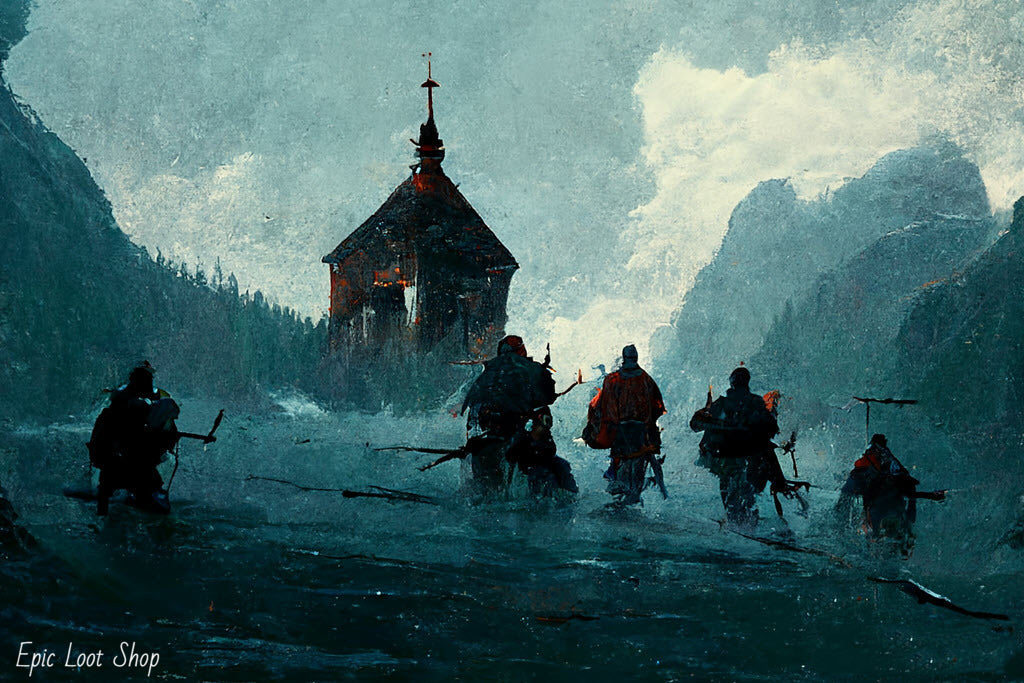Viking Raids
In the ninth century, Norsemen from Scandinavia began to sail across the North Sea and attack the coasts of western Europe. The Vikings were great explorers, traders and warriors. Their longships were fast and seaworthy, allowing them to travel long distances quickly.
The Vikings raided Ireland, Scotland and England for many years before settling there permanently. The English word "Viking" comes from an Old Norse word meaning "pirate."
Many people think of Vikings as savage barbarians who wore horned helmets and rode around on horses burning down towns and killing people. But in fact they were sophisticated seafarers who built great cities with beautiful buildings made of wood. They had advanced navigational skills that enabled them to travel all over Europe and even into North Africa!
What raids did the Vikings do?
The Vikings raided at many places in Europe, but they were especially fond of raiding the monasteries that dotted the coasts of Northern Europe. Monks were generally regarded as holy men, and so the Vikings thought it would be a good idea to steal their gold. They'd do this by sailing up to the shore with their longships and then attacking the monastery. The monks who lived there would try to run away, but since the Vikings had arrived on land in large numbers, it was very unlikely that anyone would escape.
The items that the Vikings wanted from the monks' monastery weren't just gold—they also wanted what the monks had collected from their travels. The most valuable of these was books, which were few and far between in Viking society, where knowledge was passed down through rote memorization rather than written word. The Vikings also saw value in the art and craftsmanship exhibited by their religious opponents, and so they pillaged all kinds of valuables to bring back to their home villages.
One thing that made Viking raids especially successful was that they were able to capture people as slaves while they looted. Slaves who were captured during raids were either sold or used to blackmail neighboring countries into paying off other Vikings or making political concessions. Either way,
What is the most famous Viking raid?
The most famous Viking raid in history is the sack of Lindisfarne Priory in 793. The raid was led by a Viking chieftain named Hastein, who sailed from Scandinavia to the northeastern coast of England. There, he and his men went on a rampage, killing monks and looting churches. They set boats ablaze and raided monasteries in their pursuit of gold and silver. The Lindisfarne Monastery had been open for less than two decades at the time, so it was still new and probably not yet fortified. This made it much more vulnerable to attack than it might have been later in its existence.
The Vikings also attacked Jarrow Monastery on the island of Tyne, though it's unclear whether they had already plundered Lindisfarne before heading south down the coast or if they arrived there after raiding Jarrow. Either way, they were able to get their hands on even more treasure. They killed some monks and took others with them as slaves. Even today, archeologists are still discovering relics from that period in these locations—evidence that the Vikings really did leave their mark on Britain in ways we can still see today.
Where did Vikings raid the most?
When the Vikings first started their raids on European shores, they were mainly concentrated in England, Ireland and France. The main reason for this was because the target of their anger (read: treasure) was mainly monasteries, which are located in these countries. These monasteries had large amounts of gold and silver, which the Vikings wanted to plunder. They also had other precious items that were highly sought after.
Monasteries were never built as defensive structures - many times, monks and nuns would live there peacefully for years without any problems. This made them easy targets for Vikings looking to raid the area. The monks and nuns working at these monasteries would have been completely unprepared for an attack by these savage slave-traders.
The raids became so frequent that these countries eventually formed a pact with each other: the Treaty of Paris (851). This treaty created a border between all three countries - Ireland, England and France - which meant that no Viking could cross over into another country without being seen as an enemy of both.
How long did Viking raids last?
The Viking raids lasted for almost 350 years, from 793 to 1066. This is a long time! It's hard to imagine living in fear for almost 350 years. But the Vikings didn't just want to raid. They wanted to stay. They wanted new homes and new lives, so they needed to conquer the areas that they raided.
The Vikings attacked by stealing and looting things like food and jewelry and weapons, but they also enslaved people to do their bidding and took over the local governments in order to control the people living there. Some of these places held strong defenses against the Vikings, but many fell easily because the people living there didn't know what was coming.
The Viking raids lasted so long because they wanted to conquer the areas that they raided. They wanted to stay in these places because they wanted their new homes. They attacked these places to steal the things they needed such as jewelry, food and weapons. They also forced people into slavery and took over the local government.
Why did the Vikings stop raiding?
In order to answer this question, we have to take a long view of history. The Viking Age was roughly 800 - 1100 AD, but that doesn't tell us why they stopped raiding (or what they were doing before or after). Most historians agree that a big part of it was Christianity.
Certainly Viking culture was changing during this period. Familial ties to Norway began to dissolve, as did the concept of being a farmer/pirate. The Viking class system became less rigidly dependent on your family's place in society. As the centuries progressed, fewer men and women joined in with the raiding culture, and more settled down and farmed.
What was the last Viking raid?
It's hard to say for certain, but it's likely that the last Viking raid was in 1066. At the time, England had been ruled by King Edward the Confessor, whose widow Edith the Fair had inherited the throne. She had remarried to a Norman lord named Harold Godwinson and became known to history as Edith Swan-Neck after her necklace. The Normans were descended from Vikings who had settled in France and taken on local customs. This new King Harold is known as "Harold II" to differentiate him from his more famous predecessor of the same name.
One of the most famous Viking raids of all time took place just three years after Harold's coronation: William, Duke of Normandy (also known as William the Conqueror) came across the channel with an army and claimed that he was coming to claim what was rightfully his—the throne of England. He landed on September 28th and met King Harold's men at Hastings on October 14th, where he defeated and killed Harold in battle. The Battle of Hastings effectively ended the Viking age in England and ushered in a new era for this country.
Conclusion
The Viknigs are certainly known for their brutal approach to battle, and indeed, it's what gives them the upper hand. However, they are also remembered for their great explorations and discoveries that lead to an improvement in European trade, as well as the ability to explore further and quicker than any other civilizations of their time. Even if they were not exactly welcomed under every ally's roof, they still managed to leave part of them in their wake.




Leave a comment